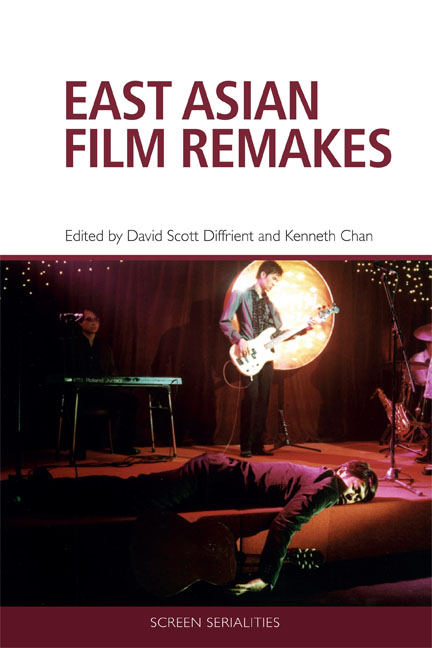Book contents
- Frontmatter
- Contents
- List of Illustrations
- Foreword
- Notes on Contributors
- Introduction: East Asian Film Remakes
- Part I Re-fleshing the Text: Sex, Seduction, Desire
- Part II Serialising Ozu: The Enduring Legacy of a Cinematic ‘Tofu Maker’
- Part III Revisiting Personal/Political Traumas in East Asian Action Films, Gangster Films and Westerns
- Part IV Local Flavours and Transcultural Flows in East Asian Comedies, Dramas and Fantasies
- Index
1 - How to Sell a Remake: The Gate of Flesh Media Franchise
Published online by Cambridge University Press: 01 March 2025
- Frontmatter
- Contents
- List of Illustrations
- Foreword
- Notes on Contributors
- Introduction: East Asian Film Remakes
- Part I Re-fleshing the Text: Sex, Seduction, Desire
- Part II Serialising Ozu: The Enduring Legacy of a Cinematic ‘Tofu Maker’
- Part III Revisiting Personal/Political Traumas in East Asian Action Films, Gangster Films and Westerns
- Part IV Local Flavours and Transcultural Flows in East Asian Comedies, Dramas and Fantasies
- Index
Summary
From Noh theatre and ukiyo-e woodblocks to radio dramas, cinema and manga, adaptations and remakes have been prevalent in the creative and cultural industries of Japan for centuries. The sheer amount of transmedial texts bears witness to the pleasure and benefits that Japanese audiences and producers have traditionally found in the repetition of familiar stories, scenarios and character types. From the early post-war era going forward, creative and cultural industries expanded at an unprecedented pace, leading to a greater crosspollination among different media outlets (film, radio, television, etc.); an increase in the number of media-literate audiences; and the consolidation of a rich tradition of criticism in print. Examining the Japanese ‘Gate of Flesh’ (Nikutai no mon) media franchise that was launched two years after the end of the Second World War and which was based on and inspired by Tamura Taijirō's novel Gate of Flesh (1947), this chapter explores the industrial contexts, textual features and critical discourses that shape the intricate relations among its iterations. Approaching remakes as a powerful means for a nation to come to (cultural) terms with its past, I hope to shed light on the cultural image of this franchise and its role over several decades in shaping the popular memory of this tumultuous historical period along gendered narratives.
As the basis for eight adaptations and remakes, including theatrically released motion pictures, a telefilm and a stage play, Tamura's original text from the immediate post-war period is regarded as a progenitive work in the cultural imagination of Japan in the aftermath of defeat. Alongside the literary output of writers such as Noma Hiroshi, Dazai Osamu and Sakaguchi Ango, Tamura's novel is representative of the ‘literature of the flesh’ (nikutai bungaku) that depicted the liberated carnal body as the gate to a new, autonomous subjectivity in opposition to the national body (kokutai) of the pre-war militarist regime that systematically repressed corporeal desires. Despite the relevance of Tamura's work and the large number of iterations it has germinated, thus far no attempt has been made to critically unpack the potential of ‘Gate of Flesh’ to further our understanding of how adaptations and remakes both capitalise on and encourage the crosspollination of cultural and creative industries in Japan, while playing an important role in the continuous remembering and reimagining of national history.
- Type
- Chapter
- Information
- East Asian Film Remakes , pp. 27 - 48Publisher: Edinburgh University PressPrint publication year: 2023

